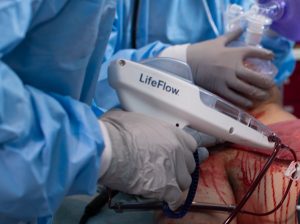
Hemorrhage is responsible for 30 to 40% of mortality in trauma patients, including gunshot victims.1,2 Time is a critical factor in the management of trauma-associated hemorrhage, and every minute that passes without adequate resuscitation significantly reduces the odds of survival.3
Early identification of hemorrhage and initiation of rapid blood administration are known to be among the most effective interventions, but traditional delivery methods often fall short due to their slow delivery rates and operational complexity.4
The following case illustrates the capability of LifeFlow PLUS, a handheld rapid infusion device, to address these challenges by delivering multiple units of blood to stabilize a patient with life-threatening blood loss from multiple gunshot wounds.
Case Presentation
A 47-year-old male presented at the back door of the CHRISTUS Highland Medical Center emergency department, stating that he had been shot and was having difficulty breathing. An assessment revealed multiple gunshot wounds to the patient’s upper middle chest and profuse hemorrhage of bright red blood.
Upon arrival, the patient’s heart rate was 141, and the rest of his vitals were unknown. Shortly after arriving the patient coded. Based on the patient’s presentation and injuries, the medical team ordered an immediate rapid blood transfusion.
Management
Once the transfusion was ordered, nurses worked to set up the Belmont rapid infuser—a device known for its notoriously complex operation.3 In the meantime, one unit of packed red blood cells (PRBCs) was administered by a nurse manually squeezing the bag in addition to 1 L of normal saline.
Fortunately, nurse Ashton Curry, the Educator for the ED at CHRISTUS Highland, was ready to grab a LifeFlow PLUS. Using the device, Ashton administered four additional units of blood in under 10 minutes—before the Belmont could be fully prepared. Each unit contained approximately 400 mL of blood.
Return of spontaneous circulation (ROSC) was achieved during the LifeFlow transfusion eight minutes after the patient initially coded. After the blood was administered, the patient was taken to the OR and then admitted to the CVICU. There, he coded twice before returning to the OR for additional procedures. The patient was then transported to a nearby trauma center and ultimately survived his injuries.
Discussion
Rapid blood transfusion is critical in trauma cases when timely and adequate resuscitation can mean the difference between life and death. Traditional methods like pressure bags and rapid infusers introduce delays and inconsistencies that can compromise patient outcomes.
Providers in this case noted that “LifeFlow was much faster than the pressure bag.”
The speed and efficiency of LifeFlow PLUS make it uniquely capable of addressing these needs, ensuring that patients receive the blood and fluid products they need quickly. LifeFlow PLUS users can set up a blood transfusion in under two minutes, and the device can deliver a unit of blood three times faster than a pressure bag.
This case demonstrates why LifeFlow PLUS should be considered an essential tool in all emergency and critical care settings. By integrating LifeFlow PLUS into their trauma protocols, hospitals can significantly enhance their ability to provide rapid, effective resuscitation, ultimately improving patient outcomes.
- Kauvar, D. S., Lefering, R., & Wade, C. E. (2006). Impact of hemorrhage on trauma outcome: An overview of epidemiology, clinical presentations, and therapeutic considerations. Journal of Trauma: Injury, Infection & Critical Care, 60(6). https://doi.org/10.1097/01.ta.0000199961.02677.19
- Callcut RA, Kornblith LZ, Conroy AS, Robles AJ, Meizoso JP, Namias N, Meyer DE, Haymaker A, Truitt MS, Agrawal V, Haan JM, Lightwine KL, Porter JM, San Roman JL, Biffl WL, Hayashi MS, Sise MJ, Badiee J, Recinos G, Inaba K, Schroeppel TJ, Callaghan E, Dunn JA, Godin S, McIntyre RC Jr, Peltz ED, OʼNeill PJ, Diven CF, Scifres AM, Switzer EE, West MA, Storrs S, Cullinane DC, Cordova JF, Moore EE, Moore HB, Privette AR, Eriksson EA, Cohen MJ; Western Trauma Association Multicenter Study Group. The why and how our trauma patients die: A prospective Multicenter Western Trauma Association study. Journal of Trauma and Acute Care Surgery. 2019;86(5):864-870.
- Piehl, M., Park, C.W. When Minutes Matter: Rapid Infusion in Emergency Care. Curr Emerg Hosp Med Rep9, 116–125 (2021). https://doi.org/10.1007/s40138-021-00237-6
- Robertson G, Lane A, Piehl M, Whitefill T, Spangler H. Comparison of a novel rapid fluid delivery device to traditional methods. https://410medical.com/wp-content/uploads/2018/03/Infusion-Rate-Comparison-of-LifeFlow-to-Traditional-Methods.pdf.

